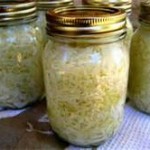Hudson Valley lactic acid fermentation
Lacto-fermentation is a centuries old method for preserving excess vegetable yields at the end of the growing season. While lacto-fermented foods like sauerkraut and European style dilled pickles resemble many other “pickled” foods, the process is quite different than the traditional hot canning method that involves preserving agents like vinegar and sugar. During lacto-fermentation vegetables are cut or shredded, and salt is added. The salt draws out liquid within the vegetables and the vegetables actually ferment within their juices for a short period of time, usually two to six weeks.
The probiotic health benefits of lacto-fermented foods are similar to that of other foods with live cultures, like yogurt and kefir. Eating lacto-fermented foods with high probiotic concentrations ensures the maintenance of high levels of probiotic bacteria within the gastrointestinal tract that help ward off harmful bacteria and intestinal and digestive sicknesses.
Louise Frazier, Lacto-fermentation expert of the Hudson Valley
A pioneer of lacto-fermenting educational outreach in the Hudson Valley, Louise Frazier was a nutritional culinary specialist and author of Vegetables First, Home Lactic Acid Fermentation of Vegetables and Around the Calender with Local Vegetables. Louise regularly conducted lacto-fermentation workshops with fresh organic produce from local farms, and talked about how she learned the art of lacto-fermentation from Thomas Stenius while visiting Sweden. She often spoke of the nuances that affect lacto-fermentation including the necessity of organic vegetables in the process.
“Vegetables that are chemically fertilized or subjected to chemical insecticides do not have the capacity to produce the bacteria essential to lactic-acid fermentation” (Vegetables First).
Incredibly high in probiotic matter, organic cabbage is ideally suited for lacto-fermentation. Because of the high probiotic concentration, Louise was known to add a handful of shredded cabbage to other lacto-fermenting vegetables to kick-start the fermentation process.
As for the lacto-fermentation method, the process and ratio of salt to vegetables is very simple. For every one pound or cut of shredded vegetables, one teaspoon of salt is added. The vegetables are packed tightly into glass jars with rubber sealed clamp lids. The rubber seals allow bubbling and fermenting juices to escape. After three to four days of active fermentation in a room temperature setting, the vegetables finish fermenting in a cooler 50-60 degree location and are later stored in a cold storage area which stalls the fermentation process. It is not necessary to hot-water bath lacto-fermented vegetables and under ideal refrigeration the vegetables will maintain excellent quality for a year or more.
Sauerkraut

By Noah Published: November 21, 2016
- Yield: 10 Servings
A tried and true sauerkraut recipe from Louise Frazier, nutritional culinary specialist and author of Vegetables First, Home Lactic Acid Fermentation of Vegetables and Around the Calender with Local Vegetables
Ingredients
- 10 pounds organic cabbage at room temp, take out most of the core and shred by hand or in a food processor
- 1/4 cup Celtic sea salt (non-iodized) dried and ground (or use other unrefined salt ground up)
- 4 teaspoons caraway seed
- a few crushed juniper berries
Instructions
- Mix well and let cabbage, salt and spices sit for one half hour or so to get the cabbage juices flowing.
- Then pack tightly into container, one layer at a time, using a fist or blunt wooden pestle to compress contents and get the air out as the lacto-fermentation process takes place in an anaerobic environment.
- Fermenting sauerkraut works especially well in 1 quart glass canning jars, 2 liter glass jars with clamp lids, and larger food grade plastic pickle buckets and plastic barrels.
- For larger containers an air lock system will help the carbon dioxide bubble out and prevents oxygen from getting in.
- For the 1 quart or 2 quart containers a fairly snug lid will suffice.
- After the cabbage has been mixed, pack it into jars or a large plastic container.
- The juices will rise to the top and will form a “seal” between the kraut and the air of the outside world.
- It is important to keep the cabbage mixture submerged in the juices.
- A layer of whole cabbage leaves can be wedged on top of the cabbage with a cabbage core, or a weight can be placed on top.
- Keep the container at room temperature, 65-68 degrees, for 2 weeks before moving it to a cooler 50-60 degree space for another 6 weeks.
- Taste the cabbage after the initial 2 week period to see if it has sufficiently soured. If it has not, keep it at room temperature for a few more days.
- Just remember that the longer you keep the cabbage at room temperature, the more quickly the juices will be drawn out of it by the salt.
- This will also accelerate the souring process.

